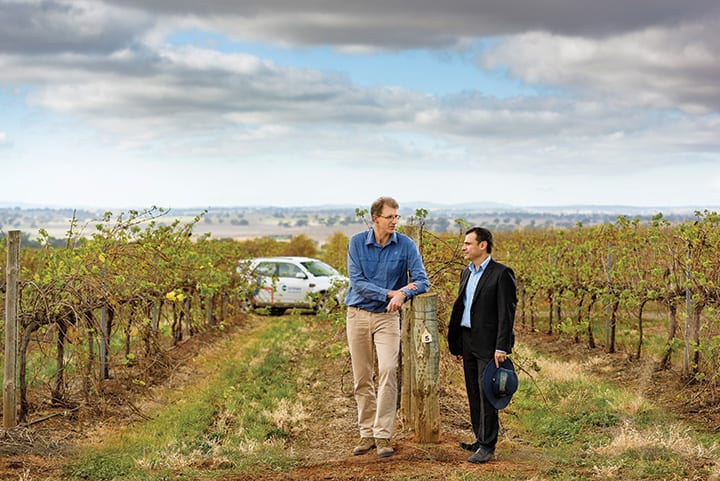For almost 20 years, SA Water has offered third-party access agreements, allowing businesses to use the spare capacity in their pipelines to transport privately-owned water. SA Water Senior Manager of Business Development, Mark Wilson, explains how this arrangement has increased revenue for the utility while decreasing prices for retail customers.
On July 1 2016, legislative changes came into effect which provide a formal process for businesses wanting to use a utility’s infrastructure to transport their private water.
While this legislation has created a framework for third-party access to water infrastructure, SA Water has been offering this level of access to its infrastructure since 1998 and, as far as they know, they are the only utility that does.
“We’re not aware of any other utilities in Australia who are offering this level of access to infrastructure in the water industry,” Mr Wilson said.
“We have, for a number of years, offered third-party access water transportation agreements to enable people who own water rights to cost-effectively transport their water to their destination. It generates an economic benefit out of the spare capacity that we have in our existing major infrastructure.”
The agreements allow often remote businesses to use spare capacity in SA Water’s existing pipelines to transport their water, which is more cost-effective than if they had to build their own infrastructure. Mr Wilson said two of the biggest regions where this arrangement currently works is in the Barossa Valley and the Clare Valley.

SA Water’s Business Development Manager Lynda Hamden and General Manager of Barossa Infrastructure Limited, Paul Shanks.
“These are major wine growing and producing regions and the quantity of naturally occurring groundwater resources in those areas is a real limitation on those regions being able to grow their production, so they needed to bring in water from another resource,” Mr Wilson said.
“They are located far enough away from the River Murray that building their own dedicated pipelines would be too expensive, so they have an agreement with us to bring their water rights out of the Murray and to their sites.
“It would be uneconomic for them to duplicate this infrastructure.”
Including Barossa Infrastructure Limited and the Clare Valley Peak Water Transportation Scheme, SA Water has 90 customers for third-party access and transports 11GL of water per annum.
The organisation is currently considering several new opportunities with industrial customers, as well as continuing working with businesses in primary production such as irrigation.
Mr Wilson says these arrangements not only benefit the business that needs to transport their water, but is advantageous to both the utility and its retail customers.
“As a utility, we benefit from this in that we are generating additional revenue from infrastructure that is not 100 per cent utilised.
“We also share some of that revenue back with our retail customers, as it puts a downward pressure on pricing. The assets that are used in these agreements are regulated assets, which are paid for by our regulated customers, so the additional revenue we get through these non-regulated arrangements contributes to the infrastructure.
“Our existing customers benefit, we benefit as a business, and most importantly, the economy of the state as a whole benefits because it enables businesses, like in the Barossa, to operate and employ people in areas where it might otherwise not be as cost-effective for them to operate,” Mr Wilson said.

SA Water’s senior engineer Leonie Elder, SA Water’s Manager of Business Development Joe Lazzaro and Taylors Wines vineyard Manager Colin Hinze.
Mr Wilson says that because capacity in these sorts of pipelines and major reservoir systems varies at different times of the year, a lot of the water that SA Water transports for these organisations is pumped during winter when there is less demand on the network.
“A number of the grape growers have their own on-farm storage that they fill up cheaply from us by transporting their water in winter, and that’s when we have the most free capacity in our network.That spare capacity varies at different times of year.”
As of 1 July 2016, South Australia now has a formal process for businesses to acquire these third-party water transportation arrangements, with the Essential Services Commission of South Australia (ESCOSA) overseeing the process.
The regime is not intended to replace commercial negotiations, but is there if businesses wish to use it. It also provides the ESCOSA with the ability to mediate should any disputes arise.
These legislation changes don’t change anything for SA Water but they do provide a structured path for businesses to follow when applying for access to their water infrastructure.
“They reflect a proper legislative structure so there’s certainty in the future on how applications for access can be made and how we go about assessing these applications.
“Not every part of our network actually has spare capacity, some parts are already fairly stretched, so the legislation provides that framework and process that people can follow in applying,” said Mr Wilson.
“It’s really about getting the right economics going on and making sure we’re utilising the spare capacity and not unnecessarily requiring new infrastructure to be built.”
Having a way to gain additional revenue for infrastructure you already own is a smart concept for Australian water utilities, but Mr Wilson says utilities must ensure there is no risk placed on existing retail customers.
“We have to be mindful that the infrastructure we’re using for this has been paid for by our retail customers so these kind of opportunities have to benefit them.

SA Water’s Business Development Manager Lynda Hamden and General Manager of Barossa Infrastructure Limited, Paul Shanks.
“We don’t want to enter into any arrangements where our retail customers are subsidising these other non-regulated activities. Ideally these arrangements will be reducing the prices for our retail customers so it’s very important we get that right,” Mr Wilson said.
Mr Wilson said transporting private water through their network is a core activity which SA Water is actively looking to grow and one that other water utilities shouldn’t be afraid of.
“We’ve been doing this for so long already so we’re comfortable with it. It’s actually not a scary thing for utilities to look at because when you structure these arrangements the right way, the utility can benefit from it, the existing retail customers can benefit from it and the entity seeking access benefits from it.
“Ultimately, if there is spare capacity, it makes economic sense for all parties to make use of it. While some utilities might view third-party access as something they need to defend against, we see it as an opportunity to benefit us and our retail customers.”














